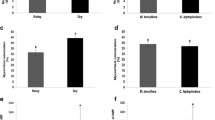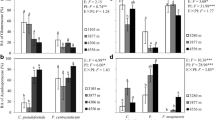Abstract
The seasonal dynamics of a community of endomycorrhizal fungal morphotypes in the roots of three grassland species (Achillea millefolium, Poa angustifolia, Plantago lanceolata) was evaluated, together with the effects of experimental treatment (mowing and phosphorus application) and the host plant properties.
Strong seasonal variability was found in the fungal community, where clear seasonal patterns can be distinguished for several fungal morphotypes. The sampling date explained 20 to 30% of the total compositional variability for all three host species. ThePlantago roots host the highest number of arbuscular mycorrhizal (AM) fungal populations. There are two co-dominant fungal morphotypes inAchillea roots (assigned to the generaScutellospora andGlomus) and only one strongly dominant morphotype (assigned toGlomus), in thePoa roots. All three host species have a comparable pattern of richness of AM morphotypes with a single peak in the summer, possibly aligned with the flowering time of the host.
This study found only a limited effect of mowing (on the abundance ofScutellospora-like morphotypes in thePoa roots) and no effect of fertilization with phosphorus. The effect of developmental age of individual host plants on the composition of the endomycorrhizal community was found inPlantago, but not inAchillea orPoa.
Similar content being viewed by others
References
Abbott L.K. (1982): Comparative anatomy of vesicular-arbuscular mycorrhizas formed on subterranean clover.Austral. J. Bot. 30: 485–499.
Allen M.F. (1982): Influence of vesicular-arbuscular mycorrhizae on water movement throughBouteloua gracilis.New Phytol. 91: 191–196.
Bentivenga S.P. &Hetrick B.A.D. (1992): The effect of prairie management practices on mycorrhizal symbiosis.Mycologia 84: 522–527.
Bever J.D., Morton J.B., Antonovics J. &Schultz P.A. (1996): Host-dependent sporulation and species diversity of arbuscular mycorrhizal fungi in a mown grassland.J. Ecol. 84: 71–82.
Blaschke H. (1991): Distribution, mycorrhizal infection, and structure of roots of calcicole floral elements at treeline, Bavarian Alps, Germany.Arctic Alpine Res. 23: 444–450.
Brundrett M. &Kendrick B. (1990): The roots and mycorrhizas of herbaceous woodland plants. II. Structural aspects of morphology.New Phytol. 114: 469–479.
Christie P. &Kilpatrick D.J. (1992): Vesicular-arbuscular mycorrhiza infection in cut grassland following long-term slurry application.Soil Biol. Biochem. 24: 325–330.
Clapp J.P., Young J.P.W., Merryweather J.W. &Fitter A.H. (1995): Diversity of fungal symbionts in arbuscular mycorrhizas from a natural community.New Phytol. 130: 259–265.
Egerton-Warburton L.M. &Allen E.B. (2000): Shifts in arbuscular mycorrhizal communities along an anthropogenic nitrogen deposition gradient.Ecol. Appl. 10: 484–496.
Eom A.H., Hartnett D.C. &Wilson G.W.T. (2000): Host plant species effects on arbuscular mycorrhizal fungal communities in tallgrass prairie.Oecologia 122: 435–444.
Fitter A.H. (1977): Influence of mycorrhizal infection on competition for phosphorus and potassium by two grasses.New Phytol. 79: 119–125.
Francis R. &Read D.J. (1994): The contributions of mycorrhizal fungi to the determination of plant community structure.Pl. & Soil 159: 11–25.
Gange A.C. &West H.M. (1994): Interactions between arbuscular mycorrhizal fungi and foliar-feeding insects inPlantago lanceolata.New Phytol. 128: 79–87.
Gemma J.N., Koske R.E. &Carreiro M. (1989): Seasonal dynamics of selected species of VA mycorrhizal fungi in a sand dune.Mycol. Res. 92: 317–321.
Goverde M., van der Heijden M.G.A., Wiemken A., Sanders I.R. &Erhardt A. (2000): Arbuscular mycorrhizal fungi influence life history traits of a lepidopteran herbivore.Oecologia 125: 362–369.
Grime J.P., Mackey J.M.L, Hillier S.H. &Read D.J. (1987): Floristic diversity in a model system using experimental microcosms.Nature 328: 420–422.
Hartnett D.C., Hetrick B.A.D., Wilson G.W.T. &Gibson D.J. (1993): Mycorrhizal influence on intra- and interspecific neighbour interactions among co-occurring prairie grasses.J. Ecol. 81: 787–795.
Hartnett D.C. &Wilson G.W.T. (1999): Mycorrhizae influence plant community structure and diversity in tallgrass prairie.Ecology 80: 1187–1195.
Helgason T., Fitter A.H. &Young J.P.W. (1999): Molecular diversity of arbuscular mycorrhizal fungi colonisingHyacinthoides non-scripta (bluebell) in a seminatural woodland.Molec. Ecol. 8: 659–666.
Johnson N.C., Graham J.H. &Smith F.A. (1997): Functioning of mycorrhizal associations along the mutualism-parasitism continuum.New Phytol. 135: 575–585.
Johnson N.C., Zak D.R., Tilman D. &Pfleger F.L. (1991): Dynamics of vesicular-arbuscular mycorrhizae during old field succession.Oecologia 86: 349–358.
Lackie S.M., Garriock M.L., Peterson R.L. &Bowley S.R. (1987): Influence of host plant on the morphology of the vesicular-arbuscular mycorrhizal fungusGlomus versiforme.Symbiosis 3: 147–158.
Merryweather J. &Fitter A. (1998a): The arbuscular mycorrhizal fungi ofHyacinthoides non-scripta. 1. Diversity of fungal taxa.New Phytol. 138: 117–129.
Merryweather J. &Fitter A. (1998b): The arbuscular mycorrhizal fungi ofHyacinthoides non-scripta. 2. Seasonal and spatial patterns of fungal populations.New Phytol. 138: 131–142.
Moora M. &Zobel M. (1996): Effects of arbuscular mycorrhiza on inter- and intraspecific competition of two grassland species.Oecologia 108: 79–84.
Morton J.B., Bentivenga S.P. &Bever J.D. (1996): Discovery, measurement, and interpretation of diversity in symbiotic endomycorrhizal fungi (Glomales, Zygomycetes).Canad. J. Bot. 73, Suppl. 1: S25-S32.
Newsham K.K., Fitter A.H. &Watkinson A.R. (1994): Root pathogenic and arbuscular mycorrhizal fungi determine fecundity of asymptomatic plants in the field.J. Ecol. 82: 805–814.
Newsham K.K., Fitter A.H. &Watkinson A.R. (1995): Multi-functionality and biodiversity in arbuscular mycorrhizas.Trends Ecol. Evol. 10: 407–411.
Phillip J.M. &Hayman D.S. (1970): Improved procedures for clearing roots and staining parasitic and vesicular-arbuscular mycorrhizal fungi for rapid assessment of infection.Trans. Brit. Mycol. Soc. 55: 15–161.
Rabatin S.C. (1979): Seasonal and edaphic variations in vesicular-arbuscular mycorrhizal infection of grasses byGlomus tenuis.New Phytol. 83: 95–102.
Rillig M.C., Field C.B. &Allen M.F. (1999): Fungal root colonization responses in natural grasslands after long-term exposure to elevated atmospheric CO2.Global Change Biol. 5: 577–585.
Rothmaler W. (1976):Exkursionsflora für die Gebiete der DDR und der BRD. Kritischer Band. Volk und Wissen Volkseigener Verlag, Berlin.
Sanders I.R. &Fitter A.H. (1992): The ecology and functioning of vesicular-arbuscular mycorrhizas in co-existing grassland species I. Seasonal patterns of mycorrhizal occurrence and morphology.New Phytol. 120: 517–524.
Sanders I.R., Clapp J.P. &Wiemken A. (1996): The genetic diversity of arbuscular mycorrhizal fungi in natural ecosystems — a key to understanding the ecology and functioning of the mycorrhizal symbiosis.New Phytol. 133: 123–134.
Šmilauer P. &Šmilauerová M. (2000): Effect of AM symbiosis exclusion on grassland community composition.Folia Geobot. 35: 13–25.
Smith F.A., Jakobsen I. &Smith S.E. (2000): Spatial differences in acquisition of soil phosphate between two arbuscular mycorrhizal fungi in symbiosis withMedicago sativa.New Phytol. 147: 357–366.
Smith F.A. &Smith S.E. (1997): Structural diversity in (vesicular-)arbuscular mycorrhizal symbioses. Tansley Review No. 96.New Phytol. 137: 373–388.
Smith S.E. &Read D.J. (1997):Mycorrhizal symbioses. Ed. 2. Academic Press, London.
ter BraakC.J.F. &Šmilauer P. (1998):CANOCO reference manual and user’s guide to CANOCO for Windows. Software for canonical community ordination (version 4). Microcomputer Power, Ithaca.
Thomson B.D., Robson A.D. &Abbott L.K. (1992): The effect of long-term applications of phosphorus-fertilized on populations of vesicular-arbuscular mycorrhizal fungi in pastures.Austral. J. Agric. Res. 43: 1131–1143.
Tisserant B., Brenac V., Requena N., Jeffries P. &Dodd J.C. (1998): The detection ofGlomus spp. (arbuscular mycorrhizal fungi) forming mycorrhizas in three plants, at different stages of seedling development, using mycorrhiza-specific isozymes.New Phytol. 138: 225–239.
Titus J.H. &Lepš J.Š. (2000): The response of arbuscular mycorrhizae to fertilization, mowing, and removal of dominant species in a diverse oligotrophic wet meadow.Amer. J. Bot. 87: 392–401.
van der Heijden M.G.A. et al. (1998a): Mycorrhizal fungal diversity determines plant biodiversity, ecosystem variability and productivity.Nature 396: 69–72.
van der Heijden M.G.A. et al. (1998b): Different arbuscular mycorrhizal fungal species are potential determinants of plant community structure.Ecology 79: 2082–2091.
Wilson J.M., Trinick M.J. &Parker C.A. (1983): The identification of vesicular-arbuscular mycorrhizal fungi using immunofluorescence.Soil Biol. Biochem. 15: 439–445.
York Mycorrhiza Research Group (1999):Techniques in Arbuscular Mycorrhiza Research. York Mycorrhiza Research Group. The University of York, York.
Author information
Authors and Affiliations
Corresponding author
Rights and permissions
About this article
Cite this article
Šmilauer, P. Communities of arbuscular mycorrhizal fungi in grassland: Seasonal variability and effects of environment and host plants. Folia Geobot 36, 243–263 (2001). https://doi.org/10.1007/BF02803179
Received:
Revised:
Accepted:
Issue Date:
DOI: https://doi.org/10.1007/BF02803179




